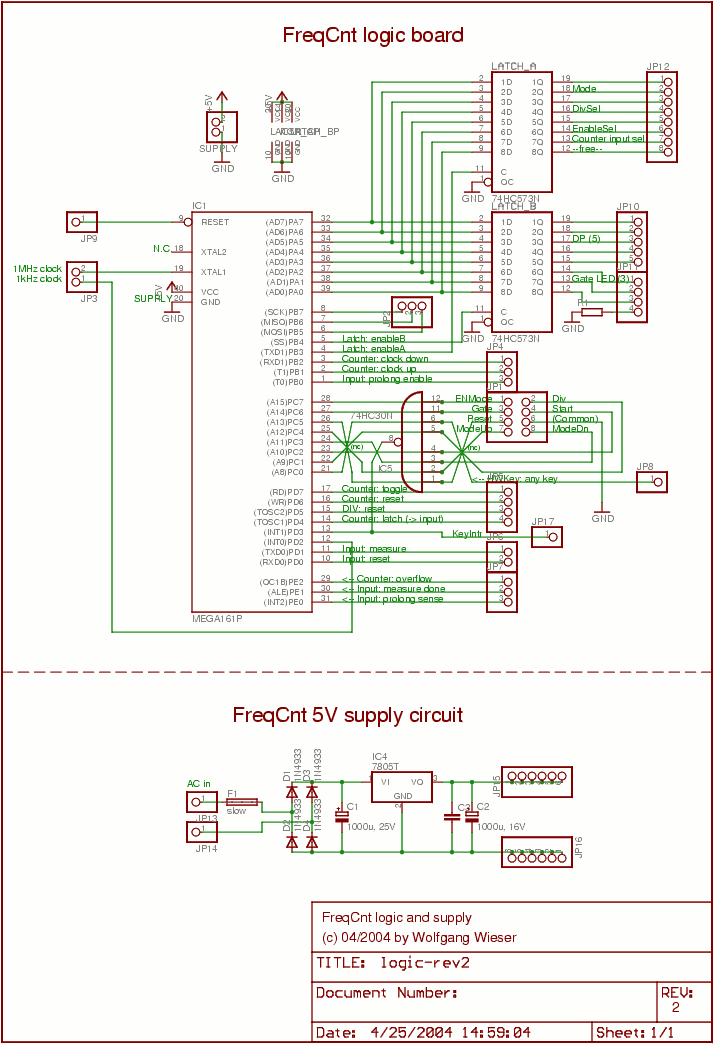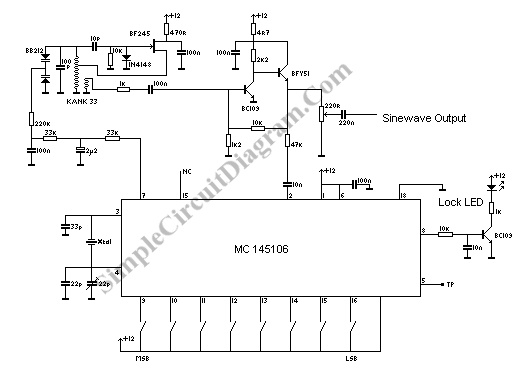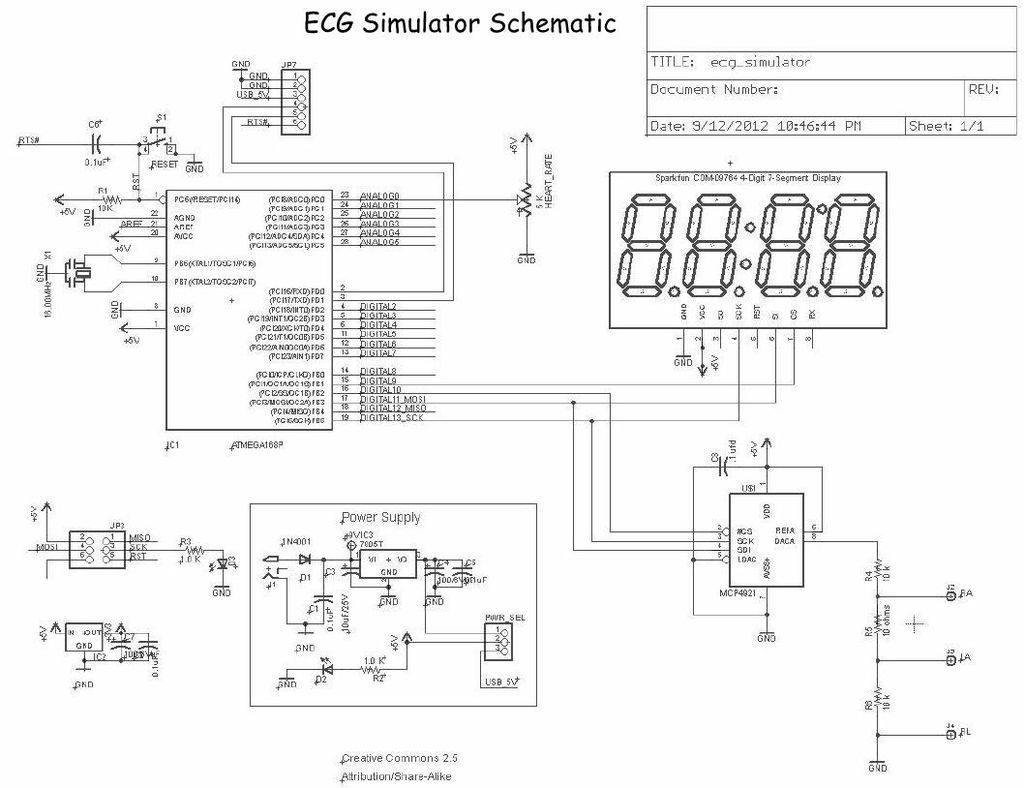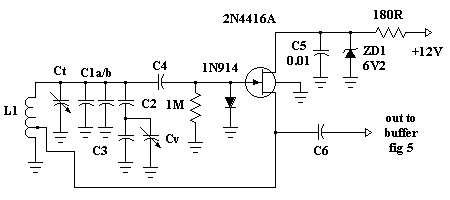
Frequency counter Logic schematic

The lower schematic represents a standard bidirectional rectifier along with capacitors and a 7805 voltage regulator, which provides a stable 5V source to power the electronic components of the frequency counter. A fuse is included for security purposes. The upper diagram depicts the main microcontroller, an ATMega161, linked to various other boards through multiple cables. Connectors JP9 (reset) and JP2 (SPI) interface with a 9-pin SUB-D service port located on the rear side. A design flaw was identified with the large gate HC30, which was not installed in its socket. The unconventional wire connections surrounding this component are intended to simplify signal routing on the PCB. The HC753 octal transparent latches maintain the current status of most LEDs on the front panel. The front panel keys connect through JP1, while the remaining connectors are adequately detailed in the schematic.
The schematic illustrates a bidirectional rectifier circuit that is essential for converting alternating current (AC) to direct current (DC), ensuring that the voltage regulator can function effectively. The 7805 voltage regulator is a popular choice for providing a fixed output voltage of 5V, which is crucial for the stable operation of digital circuits. The inclusion of capacitors in the circuit serves to filter any voltage fluctuations, thereby enhancing the reliability of the power supply.
The ATMega161 microcontroller serves as the central processing unit for the frequency counter, managing data acquisition and processing tasks. Its connections to other boards via cables facilitate communication and control among various components, ensuring that the system operates cohesively. The use of a 9-pin SUB-D service port for connecting JP9 and JP2 allows for easy access to reset and SPI communication functionalities, which are critical for programming and debugging the microcontroller.
The design flaw associated with the HC30 gate highlights the importance of thorough testing and validation in circuit design. The decision to utilize unconventional wire connections around this component indicates a pragmatic approach to overcoming layout challenges and ensuring signal integrity on the PCB.
In addition, the HC753 octal transparent latches are integral to the system, as they temporarily store the state of the front panel LEDs, allowing for visual feedback to the user. This feature enhances user interaction and provides a clear indication of the system's status. The front panel keys connected through JP1 enable user input, facilitating control over the frequency counter's operations.
Overall, the schematic effectively combines power management, microcontroller interfacing, and user interaction components, creating a robust design suitable for frequency counting applications. The detailed connections and components are crucial for ensuring the functionality and reliability of the entire system.The lower schematic is a pretty standard bidirectional rectifier together with capacitors and a 7805 as a fixed 5V source which supplies all the electronic in the frequency counter. For "security reasons" a fuse is used. The upper diagram shows the main microcontroller, an ATMega161, connected to all the other boards via various cables.
JP9 (reset ) and JP2 (SPI) are connected to the 9pin SUB-D service port at the back side. The large gate HC30 turned out to be a design flaw and was not mounted into the socket. The strange wire connections around it are due to ease signal routing on the PCB. The HC753 octal transparent latches save the current LED status of most LEDs on the front panel. The keys on the front panel are connected via JP1. The other connectors are well described in the schematic. 🔗 External reference
The schematic illustrates a bidirectional rectifier circuit that is essential for converting alternating current (AC) to direct current (DC), ensuring that the voltage regulator can function effectively. The 7805 voltage regulator is a popular choice for providing a fixed output voltage of 5V, which is crucial for the stable operation of digital circuits. The inclusion of capacitors in the circuit serves to filter any voltage fluctuations, thereby enhancing the reliability of the power supply.
The ATMega161 microcontroller serves as the central processing unit for the frequency counter, managing data acquisition and processing tasks. Its connections to other boards via cables facilitate communication and control among various components, ensuring that the system operates cohesively. The use of a 9-pin SUB-D service port for connecting JP9 and JP2 allows for easy access to reset and SPI communication functionalities, which are critical for programming and debugging the microcontroller.
The design flaw associated with the HC30 gate highlights the importance of thorough testing and validation in circuit design. The decision to utilize unconventional wire connections around this component indicates a pragmatic approach to overcoming layout challenges and ensuring signal integrity on the PCB.
In addition, the HC753 octal transparent latches are integral to the system, as they temporarily store the state of the front panel LEDs, allowing for visual feedback to the user. This feature enhances user interaction and provides a clear indication of the system's status. The front panel keys connected through JP1 enable user input, facilitating control over the frequency counter's operations.
Overall, the schematic effectively combines power management, microcontroller interfacing, and user interaction components, creating a robust design suitable for frequency counting applications. The detailed connections and components are crucial for ensuring the functionality and reliability of the entire system.The lower schematic is a pretty standard bidirectional rectifier together with capacitors and a 7805 as a fixed 5V source which supplies all the electronic in the frequency counter. For "security reasons" a fuse is used. The upper diagram shows the main microcontroller, an ATMega161, connected to all the other boards via various cables.
JP9 (reset ) and JP2 (SPI) are connected to the 9pin SUB-D service port at the back side. The large gate HC30 turned out to be a design flaw and was not mounted into the socket. The strange wire connections around it are due to ease signal routing on the PCB. The HC753 octal transparent latches save the current LED status of most LEDs on the front panel. The keys on the front panel are connected via JP1. The other connectors are well described in the schematic. 🔗 External reference
Warning: include(partials/cookie-banner.php): Failed to open stream: Permission denied in /var/www/html/nextgr/view-circuit.php on line 713
Warning: include(): Failed opening 'partials/cookie-banner.php' for inclusion (include_path='.:/usr/share/php') in /var/www/html/nextgr/view-circuit.php on line 713





